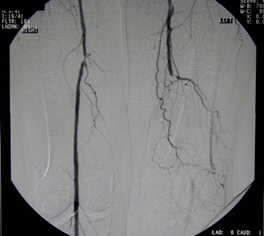Femoral Angiogram Fact Sheet
What is a Femoral Angiogram?
A femoral angiogram is an examination of the blood vessels in the legs using x-rays and contrast (x-ray dye).
A specialist known as an Interventional Radiologist often performs these procedures.
The contrast is injected through a thin plastic tube called a catheter, which is passed through a sheath inserted into the femoral artery.

Why do I need this procedure?
Your Doctor has asked for this femoral angiogram procedure to be performed because you may experience some or all of the following symptoms;
- Pain in the legs when walking short distances,
- Pain in the legs at rest, especially at night,
- Pins and needles in your extremities,
- Non-healing ulcers on your legs.
A narrowing or blockage of the blood vessel most commonly causes these symptoms.
What should I expect?
- The procedure can take between 20 – 60mins.
- The contrast can cause a warm flushing or burning sensation. It only last for a few seconds and stops once the contrast has stopped being injected. Please ring MIVIR if you have a known allergy to Iodine or contrast.
- You may be required to take some time off work – please let the nurses know so they can organise a medical certificate for you. An attendance certificate can be provided for your carer.
- Please make sure you have someone to pick you up after your procedure. You procedure will be cancelled if you don’t have an escort. Please contact MIVIR as soon as possible if this cannot be arranged.
On the day of your Procedure
You will need to present to the Day Procedure Unit on the day of your procedure. This will allow the nurses time to complete your admission paperwork and any other tests that may be required such as blood tests or pre-medication.
You will be required to fast for 4 hours before your procedure – this means no food or fluids. You may take any regular medication with a small sip of water. Please continue to take your blood pressure medication. Please bring all of your regular medications with you.
Please contact MIVIR if you are taking medication for the following;
- Diabetes,
- Stroke,
- Heart Conditions such as a Heart Attack or Atrial Fibrillation.
Author: Dr John Vrazas
